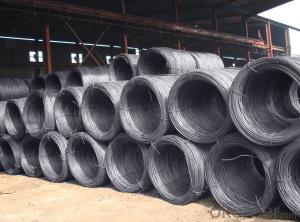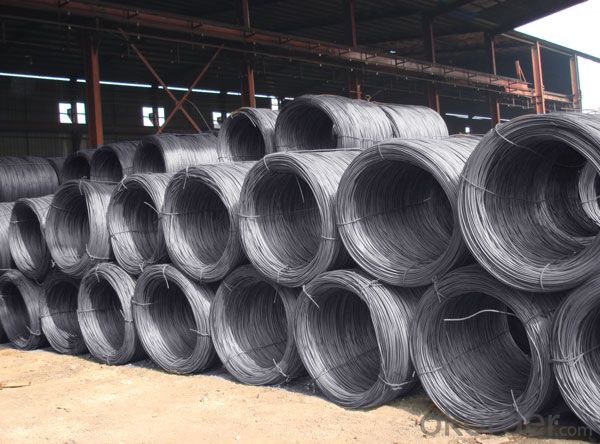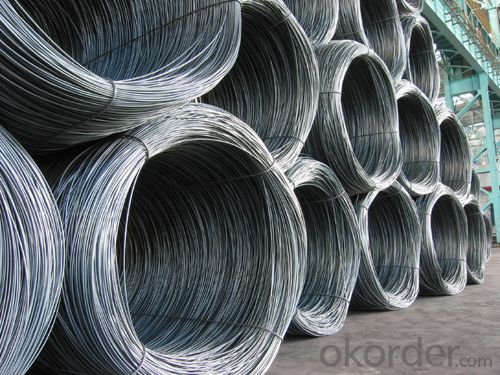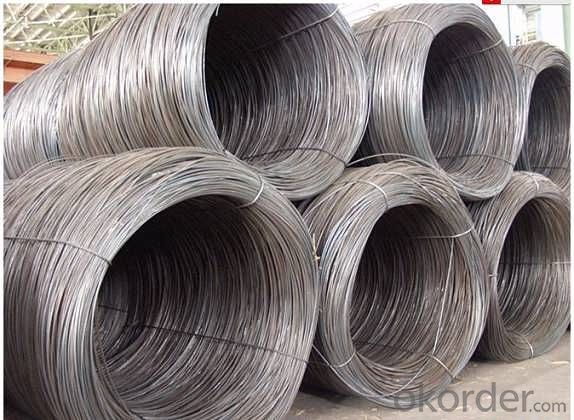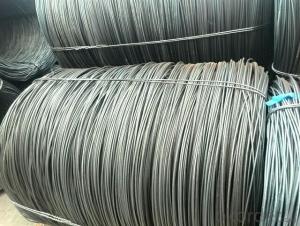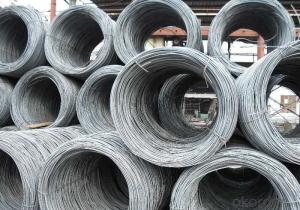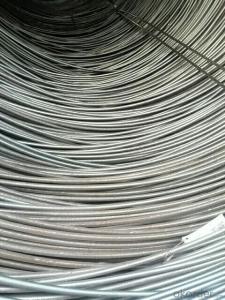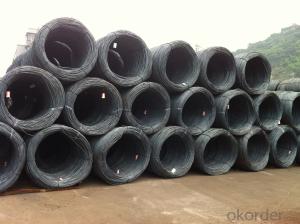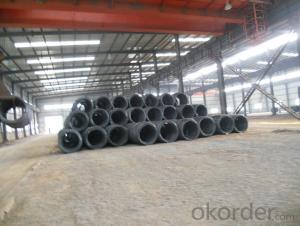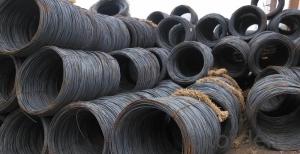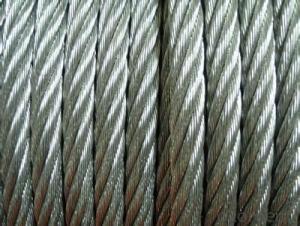Hot rolled high quality wire rod SAE1008 SAE1006
- Loading Port:
- Shanghai
- Payment Terms:
- TT OR LC
- Min Order Qty:
- 25 m.t.
- Supply Capability:
- 20000000 m.t./month
OKorder Service Pledge
OKorder Financial Service
You Might Also Like
WIRE ROD Details:
| Minimum Order Quantity: | m.t. | Unit: | m.t. | Loading Port: | |
| Supply Ability: | m.t./month | Payment Terms: | TT OR LC |
Product Description:
Steel Grade: Q195 Standard: ASTM, GB
Diameter: 5.5mm, 6.5mm, 7mm,8mm,9mm,10mm,12mm,14mm
6.5mm can be drawing into 2mm/8.0mm can be drawing into 3mm
Type: Drawn Wire in Coil, each coil weight about 2MT
Brand Name: N-RIVER Place of Origin: Hebei, China
Chemical Composition:
Please kindly find our chemistry of our material based on Q195 as below for your information
Trademark | Rank | Chemical composition (quality score) % | |||||
C | Si | Mn | S | P | |||
≤ | ≤ | ≤ | |||||
Q195 | 0.06-0.12 | 0.30 | 0.25 | 0.050 | 0.045 | ||
Trademark | Rank | Pulling Test | |||||
Bend PointΔs/Mpa | Tensile Strength | Elongation Ratioδ5% | |||||
Thickness (Diameter) /MM | Thickness (Diameter) /MM | ||||||
≤16 | 16-40 | ≤16 | 16-40 | ||||
≥ | ≥ | ||||||
Q195 | 195 | 185 | 315-390 | 33 | 32 | ||
Usage and Applications of Wire Rod Q195:
After hot-rolled the products shaped into coil and delivery as finished product, including round, square, rectangular, hexagonal and so on. Since most of the products are round, it is generally called wire rod. Carbon steel wire rod is widely used in construction and manufacturing. Carbon steel wire rod is mainly used for reinforcement of reinforced concrete and welded structure or reprocessed (roberts , nail, etc.) materials, especially used to produce wire drawing, welding electrode, nails, spring, electronic, precise machinery parts and so on
Wire Rod in Container
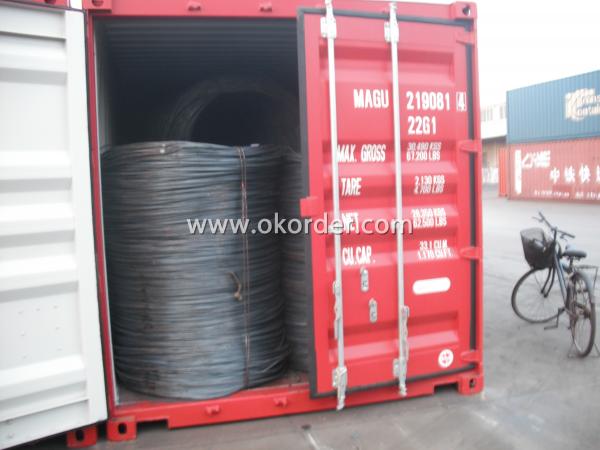
Wire Rod in Bulk Vessel
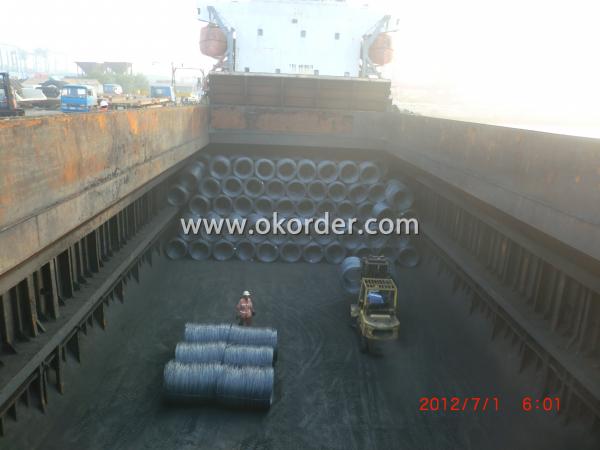
Note:
- Q: How is steel wire rod used in the manufacturing of medical devices?
- Steel wire rod is commonly used in the manufacturing of medical devices due to its strength, durability, and flexibility. It is often used as a base material for various components such as springs, wires, and cables, which are crucial for the functionality and structural integrity of medical devices. Steel wire rods can be shaped, bent, and cut into precise dimensions to meet the specific requirements of medical devices, ensuring their reliability and performance. Additionally, steel wire rods are often coated with biocompatible materials to enhance their corrosion resistance and compatibility with the human body.
- Q: What are the common applications of alloy and oil tempered steel wire rod?
- Alloy and oil tempered steel wire rods are commonly used in various industries and applications. These include automotive manufacturing, construction, aerospace, electrical, and general engineering. Alloy steel wire rods are utilized in the production of high-strength components such as springs, fasteners, gears, and shafts. Oil tempered steel wire rods, on the other hand, are specifically designed for applications requiring excellent durability and resistance to wear, making them suitable for manufacturing high-quality springs, suspension systems, and tools.
- Q: What are the common production processes for molybdenum-coated steel wire rod?
- The common production processes for molybdenum-coated steel wire rod include cleaning and pre-treatment of the steel wire, application of molybdenum coating through methods like electroplating or thermal spraying, and post-treatment processes such as drying and curing to ensure a durable and uniform coating.
- Q: How is steel wire rod used in the manufacturing of wire for elevator counterweights?
- Steel wire rod is an essential component in the manufacturing of wire for elevator counterweights. The process begins with high-quality steel wire rods, which are typically made from carbon or alloy steel. These rods are subjected to a series of manufacturing processes to transform them into wire that meets the specific requirements for elevator counterweights. Firstly, the steel wire rods are cleaned and descaled to remove any impurities or surface contaminants. This ensures that the wire produced is of the highest quality and has excellent corrosion resistance. Next, the rods go through the process of drawing, where they are pulled through a series of dies to reduce their diameter and increase their length. This process imparts the desired tensile strength and flexibility to the wire. After the drawing process, the wire is usually annealed to relieve any internal stresses and enhance its ductility. This involves heating the wire to a specific temperature and then slowly cooling it. Annealing not only improves the mechanical properties of the wire but also enhances its resistance to fatigue and wear. Once the wire has been drawn and annealed, it undergoes surface treatment processes such as coating or galvanizing. Coating the wire with a protective layer, such as zinc or epoxy, helps to prevent corrosion and extend its lifespan. Galvanizing involves dipping the wire into a bath of molten zinc to create a protective zinc coating, which provides excellent corrosion resistance. Finally, the coated or galvanized wire is further processed to achieve the desired shape and size for elevator counterweights. It can be cut into specific lengths or wound onto spools for easier handling during the manufacturing process. The wire is then used to form the internal structure of elevator counterweights, which are crucial for balancing the elevator car and ensuring its smooth operation. In summary, steel wire rods play a vital role in the manufacturing of wire for elevator counterweights. They are subjected to various processes, including cleaning, drawing, annealing, and surface treatment, to produce high-quality wire with the necessary strength, flexibility, and corrosion resistance. This wire is then used to construct the internal structure of elevator counterweights, ensuring the safe and efficient operation of elevators.
- Q: How is steel wire rod used in the manufacturing of screws and bolts?
- Steel wire rod is an essential component in the manufacturing process of screws and bolts. It serves as the raw material from which these fasteners are formed. The steel wire rod undergoes a series of manufacturing processes to transform it into screws and bolts. Firstly, the steel wire rod is heated to a high temperature to soften it. This process, known as annealing, makes the wire rod more malleable and easier to work with. Once the wire rod is heated, it is then passed through a series of dies to shape it into the desired form. These dies are specifically designed to create the thread pattern of the screw or bolt. After the wire rod has been shaped, it is cut into appropriate lengths to form individual screws or bolts. These lengths are then further processed to add the necessary features, such as the head shape and slot or recess for screwdrivers. In some cases, the wire rod may also be treated with various coatings or finishes to enhance its durability and corrosion resistance. The use of steel wire rod in the manufacturing of screws and bolts offers several advantages. Steel is known for its strength and durability, making it an ideal material for fasteners that need to withstand high levels of stress or tension. Additionally, steel wire rod is readily available and cost-effective, making it a popular choice for mass production. In conclusion, steel wire rod plays a vital role in the manufacturing of screws and bolts. It serves as the starting material, which is shaped and processed to create the final product. The use of steel wire rod ensures that screws and bolts are strong, durable, and able to fulfill their intended purpose in various applications.
- Q: How is steel wire rod used in the production of wire strands for cable-stayed bridges?
- Steel wire rod is a crucial component in the production of wire strands for cable-stayed bridges. These wire strands are essential for providing structural stability and load-bearing capacity to the bridge. To begin with, steel wire rods are manufactured with precise chemical compositions and mechanical properties to ensure their suitability for this application. These wire rods are typically made from high-strength steel alloys, such as carbon or alloy steel, which can withstand the immense tension and stress experienced by cable-stayed bridges. The first step in the production process involves drawing the steel wire rod through a series of dies to reduce its diameter. This process, known as wire drawing, imparts a higher tensile strength to the wire strand by aligning the crystal structure of the steel and eliminating impurities. The resulting wire strand is now capable of withstanding substantial loads. Once the wire strands are formed, they are galvanized or coated with a corrosion-resistant material. This coating protects the steel from environmental factors, such as moisture and chemicals, which could cause corrosion and compromise the integrity of the bridge. After the wire strands have been coated, they are assembled into bundles to form the cable-stayed bridge's main supporting structure. The number of wire strands used, along with their arrangement and tensioning, depends on the design requirements of the specific bridge. These wire strands are typically anchored to the bridge deck and tower, providing support and distributing the load across the structure. The final step involves tensioning the wire strands to their specified levels, ensuring that they can bear the anticipated loads and maintain the bridge's stability. This tensioning process is crucial for achieving the desired sag and shape of the bridge, as well as distributing the forces evenly among the wire strands. In summary, steel wire rod plays a vital role in the production of wire strands for cable-stayed bridges. It provides the necessary strength and durability to withstand the immense loads and forces exerted on these structures. Through a series of manufacturing processes, the wire rod is transformed into wire strands that are galvanized, bundled, and tensioned to create a stable and reliable supporting system for cable-stayed bridges.
- Q: How is steel wire rod different from steel bars?
- Steel wire rod and steel bars are both made from steel, but they differ in terms of their shape and size. Steel wire rod is a long, thin, and cylindrical product, typically with a diameter ranging from 5.5mm to 20mm. It is primarily used as a raw material in the manufacturing of various steel products, including nails, wires, and reinforcement materials. On the other hand, steel bars are solid, straight, and usually have a larger diameter compared to wire rods. They are commonly used in construction projects as structural components, such as beams, columns, and reinforcing bars in concrete structures. Therefore, the key distinction lies in their shape and application in different industries.
- Q: How is steel wire rod tested for straightness?
- Steel wire rod is typically tested for straightness through a process called the "straightening test." In this test, the wire rod is placed horizontally on a flat surface, and a straightedge or measuring instrument is used to check for any deviations from straightness. The wire rod is then rotated, and the process is repeated at different points along its length. Any excessive bends or deviations from the straight line are measured, and if they fall within the specified tolerance limits, the wire rod is considered to be straight.
- Q: What is the average diameter of steel wire rod?
- The average diameter of steel wire rod varies depending on its intended application and industry standards. However, it typically ranges from 5.5 millimeters to 14 millimeters.
- Q: What are the common alloying elements in steel wire rod?
- The common alloying elements in steel wire rod are typically carbon, manganese, silicon, and sometimes small amounts of sulfur and phosphorous. These alloying elements are added to steel in order to enhance its mechanical properties and improve its performance in specific applications. Carbon is the primary alloying element in steel, as it increases hardness and strength. Manganese improves steel's strength and toughness, while silicon contributes to its strength and resistance to oxidation. Sulfur and phosphorous are typically present in very small amounts and are considered impurities, but can have a positive effect on machinability and free-cutting properties of the steel. It is important to note that the specific alloying elements and their proportions can vary depending on the desired properties and intended use of the steel wire rod.
Send your message to us
Hot rolled high quality wire rod SAE1008 SAE1006
- Loading Port:
- Shanghai
- Payment Terms:
- TT OR LC
- Min Order Qty:
- 25 m.t.
- Supply Capability:
- 20000000 m.t./month
OKorder Service Pledge
OKorder Financial Service
Similar products
Hot products
Hot Searches
Related keywords
